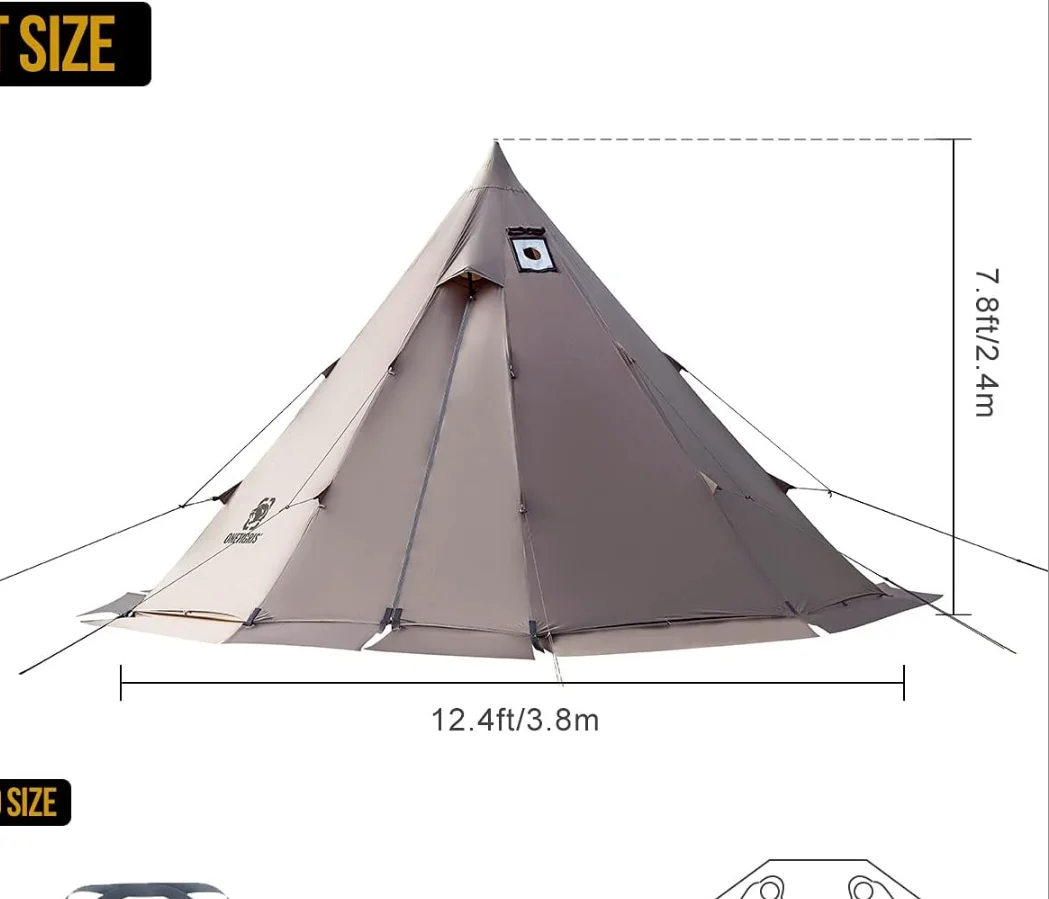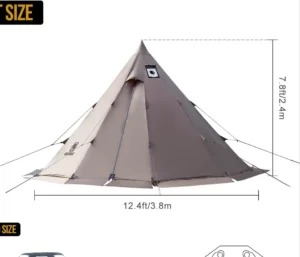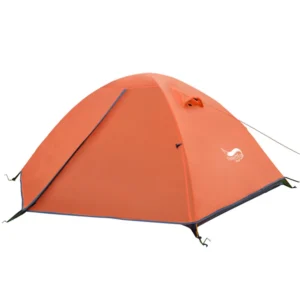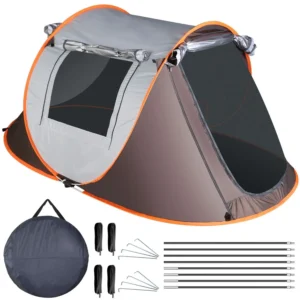Mountaineering Tent
Ready for your high-altitude expedition? Our mountaineering tents offer robust 4-season shelter, standing strong against harsh winds and heavy snow to keep you secure.

Showing all 2 results
Heavy Duty 4 Season Tent, Mountaineering Tent, Winter Camping Tent
$821.95 Select options This product has multiple variants. The options may be chosen on the product pageHeavy Duty 4 Season Tent, Mountaineering Tent, Winter Camping Tent
$870.40 Select options This product has multiple variants. The options may be chosen on the product page
Showing all 2 results
Ultimate Mountaineering Tents: Expedition-Grade Shelter for Extreme Adventures
Mountaineering tents represent the pinnacle of outdoor shelter engineering, designed specifically to withstand nature’s most brutal conditions. Unlike standard camping equipment, these specialized shelters are built to endure extreme alpine environments where sudden storms, powerful winds, and heavy snow loads are common challenges.
At Explore Elements, we understand that when you’re perched on an exposed ridge at 14,000 feet with 40 mph winds and temperatures plummeting below zero, your tent becomes your lifeline. Our mountaineering tents feature reinforced construction, strategic pole arrangements, and weather-resistant materials that have been field-tested in some of the world’s harshest environments—from the windswept peaks of major mountain ranges to the punishing conditions of high-altitude base camps.
What Sets Mountaineering Tents Apart from Regular Camping Equipment
Mountaineering tents are fundamentally different from standard camping shelters in their design philosophy and construction. While regular camping tents prioritize space, weight, and fair-weather comfort, mountaineering tents are engineered with survival as the primary concern.
The key differences include:
- Structural Integrity: Geodesic or semi-geodesic designs with multiple pole crossings create a self-supporting structure that can withstand 40+ mph winds, while typical camping tents may begin to fail at 20-25 mph
- Weather Resistance: True 4-season rating with reinforced anchor points, specialized ventilation systems, and steep-walled designs that prevent snow accumulation
- Materials: Higher denier fabrics (often 50-70D compared to 20-30D in regular tents) and specialized pole materials like DAC Featherlite NSL aluminum that offer superior strength-to-weight ratios
- Construction Techniques: Reinforced stress points, more substantial seam sealing, and specialized features like snow skirts and multiple guy-out points
These technical advantages translate directly to capability and safety in alpine environments where regular tents would quickly fail, leaving you exposed to potentially life-threatening conditions.
Essential Features of High-Performance Mountaineering Tents
- Geodesic/Semi-Geodesic Design: Multiple pole crossings create triangulated structures that distribute stress evenly, preventing collapse under wind or snow load
- Reinforced Pole Structure: Typically featuring 9-11mm diameter aluminum poles (compared to 8-9mm in regular tents) for significantly improved strength
- High-Denier Ripstop Fabrics: 50-70D nylon with specialized coatings that resist tearing, abrasion, and UV degradation
- Superior Waterproofing: Hydrostatic head ratings of 1500-3000mm for flysheets and 5000-10000mm for floor materials
- Strategic Ventilation: Adjustable systems that minimize condensation while preventing snow intrusion
- Snow Skirts/Valances: Fabric extensions that seal the tent perimeter against blowing snow
- Multiple Guy-Out Points: Often 8-12 reinforced attachment points for stabilization in high winds
- Vestibule Design: Engineered for gear storage and cooking in adverse conditions while maintaining tent integrity
Structural Engineering for Extreme Stability
The backbone of any mountaineering tent lies in its pole architecture. Geodesic designs, featuring 5+ pole crossings, create multiple triangular structures that excel in all-direction stability—critical when facing unpredictable mountain winds. Semi-geodesic variations (with 3-4 crossings) offer excellent strength with slight weight savings for less extreme conditions.
Most premium mountaineering tents utilize aerospace-grade aluminum alloy poles (like DAC Featherlite) with diameters of 9-11mm, providing dramatically better strength-to-weight ratio than the 8-9mm fiberglass or basic aluminum used in standard camping tents. These poles are strategically positioned to create multiple intersection points, effectively dispersing stress across the entire structure rather than concentrating it at vulnerable points.
Weather-Resistant Materials and Construction
Mountaineering tent fabrics balance three critical factors: weight, strength, and weather resistance. Premium models typically feature 50-70D ripstop nylon with specialized silicone and/or polyurethane coatings that achieve hydrostatic head ratings of 1500-3000mm for rainflies and up to 10000mm for floors.
These hydrostatic head ratings indicate water pressure resistance—a 5000mm rating means the fabric can withstand a 5-meter (16.4 ft) column of water before leaking. For perspective, heavy rain typically exerts pressure equivalent to about 1000-2000mm, while wind-driven rain or snow melt under body weight demands the higher ratings found in mountaineering tents.
Critical construction details include reinforced, taped seams; bartacked stress points; and specialized stitching patterns that maintain fabric integrity in high-stress zones—construction techniques rarely found in standard recreational tents.
Choosing the Right Mountaineering Tent for Your Expedition
Selecting the appropriate mountaineering tent requires careful consideration of your expedition’s specific demands. For technical alpine climbing where weight is paramount, a minimalist 2-person tent weighing 5-7 pounds (2.3-3.2 kg) might be ideal despite offering less living space. For extended high-altitude base camping, a slightly heavier model with enhanced storm protection and vestibule space may justify the additional 1-2 pounds (0.5-0.9 kg).
Consider your team’s size carefully—while a 3-person tent might seem spacious for two climbers, that extra space allows for gear storage, emergency shelter for another climber, or simply more comfortable extended stays during storm days. However, remember that every pound matters when you’re carrying equipment up thousands of vertical feet.
Vestibule design is particularly critical for mountaineering. Look for tents with vestibules large enough to store boots and outer layers while providing sheltered cooking space in adverse conditions. Some expedition models feature dual vestibules, allowing for separate cooking and gear storage areas that enhance livability during extended weather delays.
Performance in Extreme Conditions
True mountaineering tents distinguish themselves when conditions deteriorate beyond what recreational equipment can handle. Quality models can withstand sustained winds of 40-50 mph (64-80 km/h) with gusts significantly higher when properly anchored. Their specialized pole geometries and reinforced fabrics support snow loads of 1-2 feet (30-60 cm) without collapsing—critical when unexpected overnight storms hit.
Condensation management becomes vital in extreme environments where moisture can freeze inside your shelter. Premium mountaineering tents incorporate sophisticated ventilation systems with adjustable, protected openings that allow moisture to escape while preventing snow intrusion. This balance of airflow and weather protection represents years of field-testing and engineering refinement.
UV resistance is another often-overlooked factor. At high altitudes, solar radiation increases dramatically, causing standard tent fabrics to degrade rapidly. Mountaineering-specific materials incorporate UV stabilizers that maintain structural integrity through extended high-altitude exposure, ensuring your shelter doesn’t fail when you need it most.
Essential Accessories for Your Mountaineering Tent System
- Footprints: Custom-sized ground cloths that extend tent floor durability while providing additional waterproofing
- Snow/Sand Stakes: Specialized anchoring systems (deadman anchors, snow flukes) that maintain tent stability in snow or loose substrates
- Guy Lines & Tensioners: Additional high-strength cords and adjusters for enhanced stability in high winds
- Repair Kit: Field-serviceable components including pole splints, fabric patches, and seam sealant
- Interior Organization: Gear lofts and pockets that maximize usable space in confined quarters
- Tent Lighting Solutions: Specialized diffusers or attachment points for headlamps to create ambient interior lighting
Setting Up Your Mountaineering Tent in Challenging Conditions
Efficient tent setup becomes critical when conditions turn dangerous. Practice establishing your shelter in various conditions before your expedition—most mountaineering tents can be erected in under 5 minutes by experienced users, even in moderate winds. In extreme conditions, consider partial assembly (securing the corners first, then incrementally adding poles) to prevent the tent from becoming a sail.
Site selection dramatically impacts tent performance and safety. Look for natural windbreaks when possible, but avoid areas of potential avalanche runout or water collection. On snow, consider stomping a platform and allowing it to harden for 20-30 minutes before pitching your tent—this creates a more stable foundation and reduces heat loss. Always carry additional guy lines and anchoring options to adapt to varied terrain from deep snow to bare rock.
What are the Different Types of Mountaineering Tents Available?
Lightweight Alpine Tents (4-6 lbs/1.8-2.7 kg): Minimalist designs prioritizing weight savings for technical climbing and short expeditions. These typically offer excellent wind resistance but more modest living space.
Expedition Base Camp Tents (7-10 lbs/3.2-4.5 kg): More spacious designs with enhanced storm protection and livability features for extended high-altitude stays. These models typically feature larger vestibules and more interior volume.
Technical Winter Tents (6-8 lbs/2.7-3.6 kg): Specialized designs with features like reinforced snow skirts, steep wall angles to shed snow, and optimized ventilation systems for extreme cold-weather performance.
How Does Tent Capacity Affect Weight and Packability for Alpine Expeditions?
The relationship between capacity and weight isn’t strictly linear in mountaineering tents. While a typical 2-person model might weigh 6-7 pounds (2.7-3.2 kg), a 3-person version often adds just 1-2 pounds (0.5-0.9 kg)—offering 50% more floor space for a 15-25% weight penalty. This efficiency makes larger tents worth considering for extended expeditions where comfort becomes increasingly important.
Packed size follows similar principles—the difference between a compressed 2-person and 3-person mountaineering tent is often just 1-2 inches (2.5-5 cm) in length and minimal differences in diameter. For teams, distributing tent components (body, rainfly, poles) among multiple packs can dramatically reduce individual loads while providing more substantial shelter for challenging conditions.





